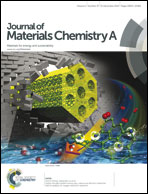Origin of the enhanced photovoltaic characteristics of PbS thin film solar cells processed at near room temperature†
Abstract
An enhanced conversion efficiency of ∼3.10% for PbS/CdS thin film solar cells without the involvement of quantum dots is demonstrated by focusing on the origin of the enhancement. The optical band gap of the PbS absorber is optimized toward a higher value by utilizing near room temperature deposition in chemical baths. Only the highest band gap of ∼1.61 eV for p-type PbS, which was obtained at 40 °C, results in a promising band alignment with an n-type CdS layer for effective light absorption and charge transfer. Both open circuit voltage and current density increase substantially to 280 mV and 20.93 mA cm−2, respectively, with the ideal adjustment of the relative band gaps. The variations in crystallite size, surface roughness, the stoichiometry ratio of S/Pb and carrier concentration are discussed as key parameters in relation to the improved band alignment and photovoltaic properties.


 Please wait while we load your content...
Please wait while we load your content...